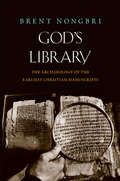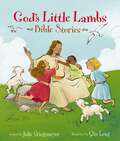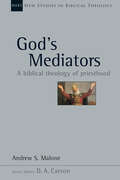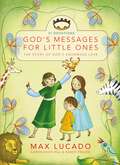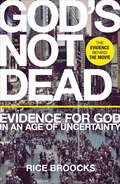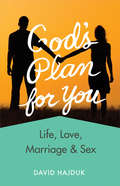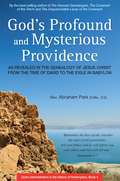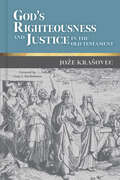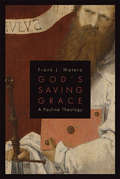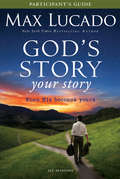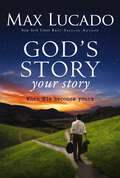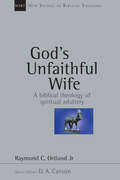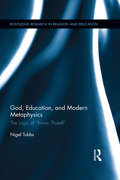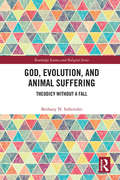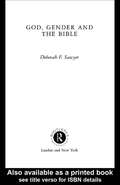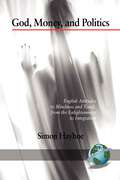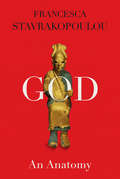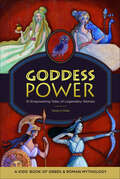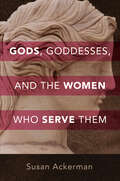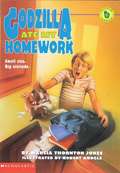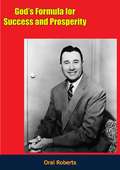- Table View
- List View
God's Library: The Archaeology of the Earliest Christian Manuscripts
by Brent NongbriA provocative book from a highly original scholar, challenging much of what we know about early Christian manuscripts In this bold and groundbreaking book, Brent Nongbri provides an up-to-date introduction to the major collections of early Christian manuscripts and demonstrates that much of what we thought we knew about these books and fragments is mistaken. While biblical scholars have expended much effort in their study of the texts contained within our earliest Christian manuscripts, there has been a surprising lack of interest in thinking about these books as material objects with individual, unique histories. We have too often ignored the ways that the antiquities market obscures our knowledge of the origins of these manuscripts. Through painstaking archival research and detailed studies of our most important collections of early Christian manuscripts, Nongbri vividly shows how the earliest Christian books are more than just carriers of texts or samples of handwriting. They are three-dimensional archaeological artifacts with fascinating stories to tell, if we’re willing to listen.
God's Little Lambs Bible Stories
by Julie Stiegemeyer Qin LengGod's Little Lambs Bible Stories is a storybook Bible written just for little ones. With a padded cover and simple, accessible text by Julie Stiegemeyer, children will learn about God’s love through stories such as Noah’s Ark, Jonah and the Big Fish, and Jesus Welcomes the Children. With soft brushstrokes and warm colors, Qin Leng provides illustrations readers will love to cuddle up with at bedtime or any time of the day.
God's Mediators: A Biblical Theology of Priesthood (New Studies in Biblical Theology #Volume 43)
by Andrew S. MaloneThere are many investigations of the Old Testament priests and the New Testament’s appropriation of such imagery for Jesus Christ. There are also studies of Israel’s corporate priesthood and what this means for the priesthood of God’s new covenant people. In this NSBT volume, Andrew S. Malone traces these two distinct threads and their intersection through Scripture with an eye to the contemporary Christian relevance.
God's Messages for Little Ones (31 Devotions)
by Max LucadoYou are never too young to talk with God! This 31-day devotional, using the words of Max Lucado, Randy Frazee, and Karen Hill in The Story for Children, guides young children to the knowledge that they are a special and important part of God&’s story of love for the world
God's Minute A Book of 365 Daily Prayers Sixty Seconds Long for Home Worship: A Collection of Biblical Wisdom and Spiritual Guidance for Christians
by 365 Eminent Clergymen and LaymenThis book of daily devotionals - one for every day of the year - contains contributions from hundreds of Christians, all distinguished in their belief and service to God and Christ's Gospel.The superb and wide-ranging selection of topics receives the name 'God's Minute', as each is designed to be read in around sixty seconds. Though characterized by brevity, the spiritual lessons and counsel provided in this book are valuable and thought-provoking. Many of the contributors were known by their congregation to use such lessons at the beginning or conclusion of a church worship; readers may opt to receive such wisdom at the beginning or end of each day.Subjects covered in this book range from the sermons of Christ, the qualities of an upstanding believer, and the overcoming of adversity. The practices of Christianity, such as the confession of sins and the use of prayer to communicate to God, or request His assistance, serve as recurring themes. How frequent trials and adversities affect us and those around us, and how we may draw upon our spiritual strength to surmount such challenges.After the conclusion of the year's devotions we also find a series of prayers for occasions of the year, such as Easter and Christmas Day.-Print ed.
God's Not Dead: Evidence for God in an Age of Uncertainty
by Rice BroocksThe evidence behind the hit movie! God&’s NotDead is apologetics for the twenty-first century, presented in clear and easy-to-follow terms. Learn to defend your faith in a world that&’s determined to tear it down.The goal of God&’s Not Dead is straightforward: to help readers develop a faith that is real and credible—and strong enough to help others find faith in God. Author Rice Broocks outlines a roadmap that guides seekers to acknowledge the most basic truths of Christianity:There is overwhelming and exciting evidence for God&’s existenceThe God who exists is indeed the God of the BibleGod has revealed his nature through his Son, Jesus ChristAs shown during the movie, this is the original book on which the main character bases much of his debate points with his atheistic professor. It contains persuasive arguments crafted with tools borrowed from logic, science, philosophy, and scripture that will solidify your faith and provide starting points for discussions with skeptics.With clear, easy-to-follow explanations of key concepts and controversies, God&’s NotDead is modern apologetics presented in layman&’s terms. You will be empowered not only to talk about your own faith with confidence, but to lead others to a relationship with Jesus.
God's Peace When You Can't Sleep
by Thomas NelsonGod&’s Peace for When I Can&’t Sleep is a wonderful means for calming the mind and soothing the spirit during drawn-out restless nights. Find Comfort and Peace during Long Sleepless NightsEvery evening, millions of people crawl into bed and struggle either to go to sleep or stay asleep through the quiet hours of the night. What's worse, lying awake during those dark and silent times can bring on a busy mind and anxious thoughts that make sleeping seem even more impossible. Instead of recharging and resting peacefully before the alarm rings, the early morning sunbeams are met with exhaustion and difficulty focusing.God's Peace for When I Can't Sleep is a wonderful means for calming the mind and soothing the spirit during those drawn-out periods of restlessness. Short and simple anecdotes, quotes, Bible verses, blessings, and prayers help direct ones thoughts toward a serene and tranquil place of rest, a place full of God's presence of peace. It's the perfect companion to keep within reach for any time of night or early morning hours.This is the first in a series of other topics such as:God's Peace for When I'm AnxiousGod's Peace for When I'm Busy (or Overwhelmed?)God's Peace for When I'm WorriedGod's Peace for When I'm Afraid
God's Plan for You (revised edition)
by David HajdukIt’s time for an updated, compelling, teen-friendly explanation of God’s plan for life, love, marriage, and sex, in light of St. John Paul II’s Theology of the Body, and that’s exactly what this book provides. This is a useful update to a very popular book that works well for individual reading but also for group study and discussion. It’s an excellent resource for youth ministers, catechists, pastors, and parents, as well as a must-read for Catholic teens.
God's Profound and Mysterious Providence
by Abraham ParkThe fourth book in the History of Redemption Series by Rev. Abraham Park, God's Profound and Mysterious Providence: As Revealed in the Genealogy of Jesus Christ from the time of David to the Exile in Babylon begins with accounts of King David and Solomon, then continues into the era of divided kingdoms: the northern kingdom of Israel and the southern kingdom of Judah. This book illustrates the reigns and lives of the kings from the perspective of God's administration for redemptive history.
God's Profound and Mysterious Providence
by Abraham ParkThe fourth book in the History of Redemption Series by Rev. Abraham Park, God's Profound and Mysterious Providence: As Revealed in the Genealogy of Jesus Christ from the time of David to the Exile in Babylon begins with accounts of King David and Solomon, then continues into the era of divided kingdoms: the northern kingdom of Israel and the southern kingdom of Judah. This book illustrates the reigns and lives of the kings from the perspective of God's administration for redemptive history.
God's Righteousness and Justice in the Old Testament
by Jože KrašovecA semantic study of God&’s righteousness and justice in the Hebrew Bible that draws exegetical, theological, and philosophical conclusions about the character of God and God&’s relationship with humanity. God&’s work of creation and salvation for the good of Israel, humanity, and the world manifests the nature of God&’s being. Thus, if we can understand God&’s characteristics of righteousness and justice, we can better understand God. In the Hebrew Bible, these aspects of God are not expressed by abstract concepts but by semantic elements within literary structures. From this premise, Jože Krašovec undertakes the present study to put semantics into dialogue with exegesis and theology to illuminate exactly how God&’s righteousness and justice in the Old Testament should be understood. In the first part of the book, Krašovec analyzes occurrences of the Hebrew root ṣdq (meaning righteous) and other synonyms, working systematically through the entire Old Testament canon. In the second part, he builds off this lexical study with a more broadly exegetical, theological, and philosophical exploration of guilt, punishment, mercy, forgiveness, and reconciliation. Krašovec concludes, among other things, that the biblical writers use &“righteousness&” as an expression of God&’s affection for faithful people, especially those in distress because of persecution. God&’s righteousness therefore exists in the Hebrew Bible in relation to the righteousness of human individuals and communities. Justice—whether in the form of forgiveness for the penitent or punishment for those who have hardened their hearts against God—is always carried out with the goal of building better community among God&’s people.
God's Saving Grace: A Pauline Theology
by Frank J. MateraDistinguished biblical scholar Frank Matera here views the theology of the Pauline letters through the lens of the saving grace that Paul experienced at his call and conversion. Focusing on Christology, soteriology, theology, anthropology, ecclesiology, ethics, and eschatology, Matera explores both the unity and the diversity of the thirteen Pauline letters.Written in a clear and coherent style, God's Saving Grace presents students, professors, and pastors with a comprehensive yet concise and accessible overview of the theology found in the entire corpus of Paul's letters.
God's Story, Your Story Participant's Guide: When His Becomes Yours
by Max LucadoIn this six-session study, popular pastor and bestselling author Max Lucado gives you a fresh perspective on how your daily life relates to God’s grand, epic story. Your journey of faith will come alive as you explore the divine narrative in New Testament and contemporary characters, and discover how the ancient stories of Scripture reveal God’s plans for you today. Join America’s favorite Christian author for a personal look at the story of God’s eternal redemption being told through your individual story right now. Designed for use with the video.
God's Story, Your Story: When His Becomes Yours (The Story)
by Max LucadoCarpools and car crashes, job switches and joint custody, moves and motionlessness. Is there a cohesive storyline to the chaos, confusion, and clutter of your daily life? According to well-loved author Max Lucado, the answer is a resounding yes! So what is the text of your life? With his unequaled warmth and honesty, Lucado plumbs the depths of your storyline and comes up smiling. “Your story indwells God’s,” writes Lucado. “This is the great promise of the Bible and the hope of this book … Above and around us God directs a grander saga, written by his hand, orchestrated by his will, unveiled according to his calendar. And you are a part of it …” Join Max for an unforgettable journey woven with New Testament stories and contemporary examples of God’s beautiful story-making skills. The beginning of the narrative is legendary, the middle unfolds with surprises still in store, and the ending of your final earthly chapter ushers in a reunion that almost defies description. It’s time to see what your life looks like when God’s story becomes your story.
God's Ultimate Passion: Unveiling the Purpose Behind Everything
by Frank ViolaGod's Ultimate Passion takes you on a guided tour of the Bible, tracing three interwoven storylines from Genesis to Revelation.
God's Unfaithful Wife: A Biblical Theology of Spiritual Adultery (New Studies in Biblical Theology #Volume 2)
by Raymond C. Ortlund Jr.The biblical theme of spiritual adultery stands in all its bluntness for a deeply offensive sin—the unfaithfulness of God's covenant people in departing from Yahweh, their husband, and going after false gods. Raymond C. Ortlund Jr. begins by showing how the Genesis vision of human marriage provides the logic and coherent network of meanings for the story of Israel's relationship with Yahweh. He traces the specific theme of marital unfaithfulness, first through the historical books of the Old Testament and then through the prophets, particularly Hosea, Jeremiah and Ezekiel. Turning to the New Testament he also shows how the sad story of Israel's adultery is transcended by the vision of ultimate reality in Christ and his church—the Bridegroom and the Bride. This beautifully written book, a New Studies in Biblical Theology volume, is marked by careful exegesis and deep sensitivity. It is that rare thing—a work of scholarship that calls readers to love God with an ardor that suffuses all of life. Addressing key issues in biblical theology, the works comprising New Studies in Biblical Theology are creative attempts to help Christians better understand their Bibles. The NSBT series is edited by D. A. Carson, aiming to simultaneously instruct and to edify, to interact with current scholarship and to point the way ahead. This book was previously published under the title Whoredom.
God, Education, and Modern Metaphysics: The Logic of "Know Thyself" (Routledge Research in Religion and Education)
by Nigel TubbsThe Western tradition has long held the view that while it is possible to know that God exists, it nevertheless remains impossible to know what God is. The ineffability of the monotheistic God extends to each of the Abrahamic faiths. In this volume, Tubbs considers Aristotle’s logic of mastery and questions the assumptions upon which God’s ineffability rests. Part I explores the tensions between the philosophical definition of the One as "thought thinking itself" (the Aristotelian concept of noesis noeseos) and the educational vocation of the individual as "know thyself" (gnothi seuton). Identifying vulnerabilities in the logic of mastery, Tubbs puts forth an original logic of education, which he calls modern metaphysics, or a logic of learning and education. Part II explores this new educational logic of the divine as a "logic of tears," as a "dreadful religious teacher," and as a way to cohere the three Abrahamic faiths in an educational concept of monotheism.
God, Evolution, and Animal Suffering: Theodicy without a Fall (Routledge Science and Religion Series)
by Bethany N. SollerederAfter the publication of On the Origin of Species in 1859, theologians were faced with the dilemma of God creating through evolution. Suddenly, pain, suffering, untimely death and extinction appeared to be the very tools of creation, and not a result of the sin of humanity. Despite this paradigm shift, the question of non-human suffering has been largely overlooked within theodicy debates, overwhelmed by the extreme human suffering of the twentieth century. This book redresses this imbalance by offering a rigorous academic treatment of the questions surrounding God and the suffering of non-human animals. Combining theological, philosophical, and biblical perspectives, this book explores the relationship between God and Creation within Christian theology. First it dismantles the popular theological view that roots violence and suffering in the animal kingdom in the fall of humanity. Then, through an exploration of the nature of love, it affirms that there are multiple reasons to suggest that God and creation can both be "good", even with the presence of violence and suffering. This is an innovative exploration of an under-examined subject that encompasses issues of theology, science, morality and human-animal interactions. As such, it will be of keen interest to scholars and academics of religion and science, the philosophy of religion, theodicy, and biblical studies.
God, Gender and the Bible (Biblical Limits)
by Deborah SawyerDeborah Sawyer discusses this crucial yet unresolved question in the context of contemporary and postmodern ideas about gender and power, based on fresh examination of a number of texts from Hebrew and Christian scripture. Such texts offer striking parallels to contemporary gender theories (particularly those of Luce Irigaray and Judith Butler), which have unravelled given notions of power and constructed identity. Through the study of gender in terms of its application by biblical writers as a theological strategy, we can observe how these writers use female characters to undermine human masculinity, through their 'higher' intention to elevate the biblical God. God Gender and the Bible demonstrates that both maleness and femaleness are constructed in the light of divine omnipotence. Unlike many approaches to the Bible that offer hegemonist interpretations, such as those that are explicitly Christian or Jewish, or liberationist or feminist, this enlightening and readable study sustains and works with the inconsistencies evident in biblical literature.
God, Money, and Politics: English Attitudes to Blindness and Touch, from the Enlightenment to Integration
by Simon HayhoeHayhoe follows the British progression of the blind as immoral, to the need for rehabilitation, to questions of an educational nature.
God: An Anatomy
by Francesca StavrakopoulouAn astonishing and revelatory history that re-presents God as he was originally envisioned by ancient worshippers—with a distinctly male body, and with superhuman powers, earthly passions, and a penchant for the fantastic and monstrous."[A] rollicking journey through every aspect of Yahweh&’s body, from top to bottom (yes, that too) and from inside out ... Ms. Stavrakopoulou has almost too much fun.&”—The Economist The scholarship of theology and religion teaches us that the God of the Bible was without a body, only revealing himself in the Old Testament in words mysteriously uttered through his prophets, and in the New Testament in the body of Christ. The portrayal of God as corporeal and masculine is seen as merely metaphorical, figurative, or poetic. But, in this revelatory study, Francesca Stavrakopoulou presents a vividly corporeal image of God: a human-shaped deity who walks and talks and weeps and laughs, who eats, sleeps, feels, and breathes, and who is undeniably male. Here is a portrait—arrived at through the author's close examination of and research into the Bible—of a god in ancient myths and rituals who was a product of a particular society, at a particular time, made in the image of the people who lived then, shaped by their own circumstances and experience of the world. From head to toe—and every part of the body in between—this is a god of stunning surprise and complexity, one we have never encountered before.
Goddess Power: 10 Empowering Tales of Legendary Women
by Yung In ChaeLet the goddesses take you on an odyssey—10 tales about Greek mythology for kids ages 9 to 12The goddesses of classical mythology ruled the heavens, mingled with mortals, and overcame tremendous odds. Goddess Power: A Kids' Book of Greek and Roman Mythology takes you on an extraordinary journey through the triumphs and tragedies of these remarkable women.From Gaia, Goddess of Earth, to Aphrodite, Goddess of Love and Beauty, these legendary ladies' stories are paired with stunning artwork that brings the myths to life. How will you be inspired by these tales about Greek mythology for kids?In this book of Greek mythology for kids, you'll find:Creature encyclopedia—Uncover the wondrous beasts of classical mythology—from Cerberus, the three-headed dog, to Typhon, a giant with fire-breathing snakes on his shoulders.Greek pronunciation guide—Find a helpful guide to pronouncing the tongue-twisting names, places, and other words found in these stories about Greek mythology for kids.Symbols and strengths—Discover what each goddess is known for and where she comes from—like Athena, the goddess of wisdom and warfare, whose symbols are an olive tree, an owl, a spear, and a shield.Explore the mysteries and lessons of life with the enchanting goddesses in this beautifully illustrated book about Greek mythology for kids.
Gods, Goddesses, and the Women Who Serve Them
by Susan AckermanA wide-ranging study of women in ancient Israelite religion. Susan Ackerman has spent her scholarly career researching underexamined aspects of the world of the Hebrew Bible—particularly those aspects pertaining to women. In this collection drawn from three decades of her work, she describes in fascinating detail the worship of goddesses in ancient Israel, the roles women played as priests and prophets, the cultic significance of queen mothers, and the Hebrew Bible&’s accounts of women&’s religious lives. Specific topics include:the &“Queen of Heaven,&” a goddess whose worship was the object of censure in the book of JeremiahAsherah, the great Canaanite mother goddess for whom Judean women were described as weaving in the book of Kingsbiblical figures considered as religious functionaries, such as Miriam, Deborah, and Zipporahthe lack of women priests in ancient Israel explored against the prevalence of priestesses in the larger ancient Near Eastern worldthe cultic significance of queen mothers in Israel and throughout the ancient Near EastIsraelite women&’s participation in the cult of Yahweh and in the cults of various goddesses
Godzilla Ate My Homework
by Marcia Thornton JonesParker has always wanted a pet, but when he gets a guinea pig, it causes him more trouble than he anticipated.
God’s Formula for Success and Prosperity
by Oral RobertsHere are eleven personal biographies, gathered and edited by G. H. Montgomery, Editor of Oral Roberts’ magazine, HEALING, to dramatically illustrate GOD’S FORMULA FOR SUCCESS AND PROSPERITY, and to prove what the power of God will do for those who use their faith in Him and live according to His laws.These eleven people tried to “out-give God,” and failed, for the more they gave of their substance and themselves, the more God prospered them.Here are eleven inspiring stories which are true. You will read them and enjoy them, and when you are discouraged, and feel that you have been passed by you will read them again and be encouraged. For this is the proof of what Oral Roberts preaches, shown in his lives of men who are unusual only because they believed, they trusted, and they gave what they had without thought of reward—and were prospered.GOD’S REAL ESTATE MANGOD’S PLOWMANGOD’S DAIRY MANGOD’S TOOL AND DIE MAKERGOD’S AUTOMOBILE MANGOD’S CONTRACTORGODS POULTRY MANGOD’S MINISTERING SERVANTGOD’S BANKERGOD’S KEEPER OF THE TOMBGOD’S MAN FOR THIS HOUR
